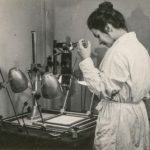 Weird Stuff
Weird Stuff  Weird Stuff
Weird Stuff  Our World
Our World 10 Ways Your Christmas Tree Is More Lit Than You Think
 Movies and TV
Movies and TV The 10 Coolest Stars to Set Sail on The Love Boat
 History
History 10 Things You Didn’t Know About the American National Anthem
 Technology
Technology Top 10 Everyday Tech Buzzwords That Hide a Darker Past
 Humans
Humans 10 Everyday Human Behaviors That Are Actually Survival Instincts
 Animals
Animals 10 Animals That Humiliated and Harmed Historical Leaders
 History
History 10 Most Influential Protests in Modern History
 Creepy
Creepy 10 More Representations of Death from Myth, Legend, and Folktale
 Technology
Technology 10 Scientific Breakthroughs of 2025 That’ll Change Everything
 Weird Stuff
Weird Stuff Ten Bizarre Facts About The Doge Meme
 Our World
Our World 10 Ways Your Christmas Tree Is More Lit Than You Think
 Movies and TV
Movies and TV The 10 Coolest Stars to Set Sail on The Love Boat
Who's Behind Listverse?

Jamie Frater
Head Editor
Jamie founded Listverse due to an insatiable desire to share fascinating, obscure, and bizarre facts. He has been a guest speaker on numerous national radio and television stations and is a five time published author.
More About Us History
History 10 Things You Didn’t Know About the American National Anthem
 Technology
Technology Top 10 Everyday Tech Buzzwords That Hide a Darker Past
 Humans
Humans 10 Everyday Human Behaviors That Are Actually Survival Instincts
 Animals
Animals 10 Animals That Humiliated and Harmed Historical Leaders
 History
History 10 Most Influential Protests in Modern History
 Creepy
Creepy 10 More Representations of Death from Myth, Legend, and Folktale
 Technology
Technology 10 Scientific Breakthroughs of 2025 That’ll Change Everything
Ten Historic Men Who Deserve Way More Credit Than They Got
There is no shortage of great men from history. From Albert Einstein, Martin Luther King Jr., Gandhi, George Washington, and Thomas Jefferson… well, we could be here all day if we just listed everybody important. But while many men who have been remembered by history are given full and proper credit for the things they achieved, there are many more who have slipped through the proverbial cracks.
Some men did critically important things that either improved or quite literally saved the world, and they were given little to no credit for their good and impressive deeds—both during their lives and long after their deaths.
So today, in this list, we are going to try to correct the record. The ten men you will read about here achieved crucial and world-changing things during their lifetimes. But for a variety of reasons, they weren’t given full credit for what they accomplished. There’s time to praise them now, though! These are the stories of ten key men from history who deserve way more credit than they got.
Related: Ten Offbeat “Hit-or-Miss” Inventions
10 Vasili Arkhipov
Vasili Arkhipov was a Soviet naval officer during the Cold War who quite literally saved the entire planet with his actions at the very height of the Cuban Missile Crisis. The date was October 27, 1962, and a group of 11 U.S. Navy destroyers, as well as the aircraft carrier USS Randolph, were in the Caribbean Sea near Cuba. There, they had located the Soviet diesel-powered, nuclear-armed submarine in which Arkhipov was riding and serving as an officer.
The submarine dove to incredible depths far down into the sea as the American ships started sending down depth charges. They wanted to force the submarine to come up to the surface in order to offer its identification to the Americans—a move that would, of course, reveal it to be a Soviet sub, perilously close to American shores and up to no good.
As the submarine dove further and further down, they lost all radio contact with Moscow. They also eventually lost the ability to listen to American radio stations that they previously could hear from their location just off shore. Because of that, and because of the continued depth charges coming from the American ships overhead, the Soviet sub’s leaders began to worry that a full-scale nuclear war may have already started. Suspecting that possibility, the captain of the submarine, Valent Grigoryevich Savitsky, wanted to launch the sub’s T-5 nuclear torpedo.
Of course, launching a nuclear torpedo at an American target in an act of war like that would have almost certainly started a full-scale nuclear war. In an instant, the Cuban Missile Crisis and the Cold War itself could have erupted into a globe-destroying nuclear battle with millions and millions of people losing their lives. But there was a catch.
Captain Savitsky needed two other officers on board his submarine to also sign off on launching the nuclear torpedo. And while one other man did indeed agree to the launch, Arkhipov balked. He wasn’t convinced a war was beginning—and of course, he was right. His act of refusing to agree to launch the torpedo in that terrifying moment undoubtedly saved the Soviets, the Americans, and the rest of the world from unimaginable, apocalyptic terror.[1]
9 Évariste Galois
Évariste Galois was a French mathematician born in 1811 and known in academic circles for making significant and groundbreaking contributions to algebra and group theory even though he only lived 20 years. Galois was a mostly self-taught mathematician who struggled with the death of his father by suicide when he was still in his teens.
However, Galois turned around that adversity into achievement when he bested the rest of the abstract algebra crowd by nearly a half-century and started carrying out proofs and confirming theorems on group theory and algebra in the late 1820s. Notably, he studied, explored, and perfected ideas related to polynomial equations and radicals in the world of numbers.
And then, just as soon as he started to really make his mark on math and society, it was all over. In 1832, before he reached his 21st birthday, Galois died in a duel. To this day, the reasons for Galois’s duel are not entirely known. However, notes written in the linings of some of his academic books that were in use at the time mention a “Stephanie.” Thus, historians believe that Galois and his dueling partner—a man named Perscheux d’Herbinville—were almost certainly fighting over the love of that woman.
On May 30, 1832, d’Herbinville shot Galois in the duel, the witnesses to the challenge all fled, and the brilliant mathematician officially passed away three days later after he was found by peasants and rushed to a local hospital. It’s tragic to think what else that young man may have accomplished had he lived a longer, full life, considering he was already doing such groundbreaking things just barely out of his teenage years.[2]
8 Jan Karski
Jan Karski was the pseudonym of a Polish man whose real name was Jan Kozielewski. At the outbreak of World War II, he was living as a diplomat in Poland. Quickly, he became a resistance fighter dead set on doing whatever he could to beat back the Nazi sweep across his country. Sadly, he and the other brave resistance fighters weren’t enough of a match to beat back Adolf Hitler’s men.
However, Kozielewski—er, Karski—ended up doing something far more important. He secretly sounded the alarm to the United States, the United Kingdom, and other nations about the atrocities the Nazis were committing against the Jews in Poland. In turn, as the Holocaust was developing into a complete and total horror, Karski was carefully and meticulously warning the Allies about what was going on so they might prepare.
It all really started in July of 1942, when the Nazis began mass deporting Jews from the ghettos of the occupied city of Warsaw, Poland. Karski saw what was going on very early in the process. He used his role as a diplomat-turned-courier for the Polish Underground to report on what was happening.
Two different times, under significant risk to himself, he snuck into the Warsaw Ghetto and was able to confirm that Jews were being shuttled into cattle cars and moved to concentration camps. Once, he even made it inside the Izbica Lubelska transit camp, which was an infamous Nazi-controlled stop on the way to the Treblinka death camp.
Sadly for Karski and the Jews who perished out of the Warsaw Ghetto and into the camps, the U.S. and the UK were slow on the uptake with what was going on. Even after he reached London personally in November of 1942, leaders in those two nations dragged their feet. He kept at them, though.
Karski prepared detailed briefings for British Foreign Secretary Anthony Eden, as well as for Poland’s Government-in-Exile that was stuck in London. He even met with President Franklin D. Roosevelt in the Oval Office in Washington, D.C., to report on the camps. Finally, after much persistence and bravery on Karski’s part, the Allies came to understand the atrocities that were being committed by the Nazis.[3]
7 Norman Borlaug
Norman Borlaug was an Iowa-born biologist who came to be known as the man who saved billions of lives thanks to his innovations with farming techniques. Yes, we said “billions” with a “b.” Sometimes called the “father of the Green Revolution,” Norman was born in a small town in the Iowa cornfields way back in 1914. In his adult life, he worked extensively with wheat and other agricultural products as a geneticist and plant pathologist.
Borlaug’s innovations in growing wheat and making it a crop that could be sustainable in massive quantities for massive amounts of people created the ability of many countries around the world to feed millions of people who were otherwise on the brink of starvation at various times through difficult droughts and bad crop cycles.
He spent decades working on developing the perfect high-yield, disease-resistant varieties of wheat that could be grown in many climates around the world. His goal was to aid impoverished farmers who wanted to grow crops to feed their families and communities. And thankfully, he succeeded in a massive way. His innovations through the latter half of the 20th century led to the phenomenon of modern plant breeding.
With that advancement, the governments of highly populated countries from Pakistan to Mexico took his advice, increased their crop yields, and saved hundreds of millions of people from the brink of starvation over multiple generations of human existence. Still today, Borlaug’s “dwarf strain” of wheat is still much-used and highly prized by many impoverished farmers and growers all around the world.
In Mexico alone, wheat production tripled after they took Borlaug’s plant breeding advice to heart. And even though Borlaug died in 2009, his impact on feeding the world’s hungry is still felt to this day.[4]
6 John Snow
John Snow was a British physician who, in the middle of the 19th century, became one of the key figures in the modern history of medicine and public health right as a cholera outbreak was terrorizing London. The year was 1854, and the Broad Street cholera outbreak was wreaking havoc among London’s poor.
Cholera had been a major scourge all across the globe at that time, with large epidemics very often decimating European cities and others as far away as the Indian subcontinent. But nobody really knew why cholera spread as quickly as it did or what conditions had to come about to allow it to unfortunately flourish and claim so many lives. That was until John Snow came around, at least.
After observing the spread of the Broad Street outbreak in 1854, Snow was able to narrow the source of the pandemic down to contaminated water in the street’s pump that was being pushed out all across the Soho District. When officials removed the handle from the pump and de-contaminated the water, the epidemic ceased. Snow then took his research a step further and started studying cholera within specific London homes. He tracked the sources from where those homes piped in their water supply.
In one home, he found that water was coming from contaminated sewage in the Thames River. In the other home, he determined clean and uncontaminated water was being pumped in from an upstream part of that same river. Sure enough, when he went back to check cholera rates in the two neighborhoods around these homes, he found them markedly higher among people living downstream who had contaminated sewage water pumped into their homes.
He laid out his demonstration for city officials and the public, and soon enough, his words were (thankfully) treated as gospel among London’s newfound sanitation movement. Over the following decades, London rolled out a series of water purification systems and better sourced the water that was being sent to downstream homes.
In turn, the threat of cholera, typhoid, and many other waterborne diseases was very greatly reduced. In that way, Snow saved thousands (or more) lives with his quick thinking and pioneering recognition of the disease as a waterborne epidemic.[5]
5 Zhang Heng
Zhang Heng was an ancient Chinese scientist, astronomer, and inventor who lived from AD 78 AD to AD 139. Despite having lived so long ago and not being privy to modern achievements and progress upon which to build, he proved he was ahead of his time as a polymath, an engineer, and a tinkerer.
Most notably, Zhang invented the very first seismoscope. He figured out a way to register not only that earthquakes had occurred but also the direction in which they happened, the (rough) area in which they were centered, and the earliest estimates about the size of various earth-shaking movements.
To do this, he set up a primitive seismoscope that was in the shape of a cylinder. Then, he arranged eight dragon head-shaped objects carefully around its circumference. Next, he placed a ball in each dragon’s mouth. Directly below the dragon’s heads were eight frogs. And when the earth quaked, and the ball fell out of the dragon’s mouth, it was caught in the frog’s mouth, registering a sound. Zhang was able to use the directional knowledge gained from seeing which dragon heads lost their balls and at what frequency and speed toward the descent to start tracking earthquakes.
That was far from the only thing he accomplished, though. As an astronomer, he cataloged more than 2,500 stars in the sky and confirmed the location and shape of 124 distinct constellations. By comparison, Hipparchus and Ptolemy only cataloged about 1,000 stars—so Zhang had ’em beat. Additionally, he is credited as the first person to ever apply hydraulic power to rotate an armillary sphere, and he is the one who historians now recognize as inventing the very first primitive odometer.
Along with all that, he was a renowned cartographer who mapped in great detail China’s land mass, rivers, and other waterways. In that project, he became the first documented person in history to make a mathematical grid reference for his maps.[6]
4 Giuseppe Garibaldi
Giuseppe Garibaldi rose to prominence in the late 19th century as an Italian general and warlord who was so prolific in battle on two different continents (and two different hemispheres!) that he came to be known as the “Hero of the Two Worlds.” As a young man in Italy in the early 1800s, Garibaldi backed a nationalist movement and wanted the country to unify under a democratic republican government. Unfortunately, that didn’t quite happen like those in power wanted it to for many different reasons.
Garibaldi himself ended up allying with the monarchists within the Kingdom of Sardinia for political reasons as they struggled for their own independence and sovereignty. Garibaldi was playing the long game, though, and realized that if he picked up friends in important places like Sardinia, he might be able to count on them later when he came back to reunify Italy.
Then, in 1835, he left the land entirely and went all the way to Brazil. There, he fought as a guerrilla warfare expert in the so-called Ragamuffin War. He wanted to help establish both the Riograndense Republic and, later, the Catarinense Republic. He even got himself involved in the Uruguayan Civil War while he was down there.
He led a group of Italian soldiers who were known as the Redshirts in a mercenary fight to help Uruguayan forces seek independence. Amazingly, to this day, Garibaldi is personally still recognized as a hero in Uruguay for his militaristic commitment to their reconstitution.
By 1848, Garibaldi had tired of his travels in South America, and he returned to Italy. There, with the goal of Italian unification as the only thing on his mind, he was made a military commander and, later, a general. In 1859, when the war of independence broke out, he went on a tear across the northern reaches of what is now modern-day Italy. Then, the following year, he tapped his past connections in Sardinia to lead an expedition to annex Sicily, Southern Italy, Marche, and Umbria.
Tying them to his old pals in the Kingdom of Sardinia, he successfully managed to completely unify Italy in March 1861. It’s amazing to think about—that Garibaldi could reunite not one but two nations on two different continents during his aggressively vicious and domineering life.[7]
3 Ignaz Semmelweis
Ignaz Semmelweis was a Hungarian physician born in 1818 and, as an adult, reputed to be the “father of infection control” after he discovered the power of doctors, nurses, and other medical practitioners washing their hands regularly in hospitals and other settings. After receiving his medical degree in Vienna in 1844, Semmelweis went on to work in hospitals in Hungary and elsewhere.
Semmelweis often helped deliver babies, and a widespread issue at the time was the postpartum infections that women dealt with after giving birth. Very frequently, those women died from their infections. And with the mortality rate so high, Semmelweis desperately wanted to find out why things were the way they were. Then, he caught a lucky break after yet another tragedy.
This time, it was the death of a pathologist friend of his. The pathologist had been doing an autopsy on a woman who died after childbirth when the man pricked his finger. His bloodstream absorbed bodily fluids from the woman, and unknown to doctors at the time, those fluids could obviously transmit disease.
When Semmelweis figured this out, a light bulb went off. Previously, doctors had thought that only women who birthed children would die from so-called postpartum fevers. But since the pathologist wasn’t a woman and obviously hadn’t given birth, that must have meant that the fever was traveling from human to human in another manner.
Semmelweis got down to brass tacks from there and deduced that doctors and nurses could spread fevers and sicknesses around by handling patients one after the other. So he started instituting policies in his hospitals that people regularly wash their hands between seeing patients and adopt other antiseptic procedures.
The results for birthing mothers were immediate and drastically positive. For that, Ignaz Semmelweis came to be known as the aforementioned “father of infection control” and also as the “savior of mothers.” And his hand-washing legacy very clearly lives on today![8]
2 Tenzing Norgay
Tenzing Norgay was the Nepalese sherpa who helped Sir Edmund Hillary navigate to the very top of Mount Everest in May of 1953. Of course, Hillary rose to worldwide fame and acclaim as the first man to ever summit the highest mountain on Earth. And he was, in fact, first.
Both men claimed at the time, and Norgay later reiterated in a book that Hillary had indeed stepped foot onto the top of Mount Everest just a couple steps before Norgay got there. The sherpa helped hold ropes and make sure lines were set properly for the explorer before he, too, joined the New Zealand-born man on the (literal) top of the world.
That said, Norgay sadly didn’t get quite the credit that Hillary did for the achievement. While Hillary was soon after knighted for his impressive drive to climb to the top of Everest, Norgay didn’t get much. He was mostly ignored by the press and then only received an honorary medal for his work. Of course, Norgay did just as much work as Hillary did to climb that mountain.
In fact, one might argue that Norgay actually did more work than Hillary. He was the one responsible for setting more of the lines, tracking rope, figuring out climbs and descents, and so forth. In recent years, there has been a major push to give Norgay more credit for his climb up Everest, and he deserves it. Both men had to very literally risk their lives to get to the top![9]
1 Ibn Battuta
Born in 1304, Ibn Battuta was without a doubt the greatest traveler and explorer of the 14th century—and honestly, of any century in all of human history up until the advent of the steam-powered engine. With only the wind at his back to sail across the seas, Ibn Battuta lived out his life, covering more than 75,000 miles (120,700.8 kilometers) in his endless journeys across Africa, Asia, and Europe.
Along the way, he painstakingly wrote up very detailed reports about the people, places, and things he visited all along the way. He called his book The Rihlah. It became a very critically important piece of literature for centuries after that, as other explorers and travelers used it to figure out what the peoples, cultures, kingdoms, and governments of new lands were like.
Battuta visited nearly every single Muslim country on the globe as part of his travels, only missing out on seeing a couple of them in his lifetime. He went all over North Africa and the Middle East. He traveled extensively through Europe, too. And he even made it as far as China and Sumatra—now a part of distant Indonesia. While on his travels, he met more than 60 rulers of various kingdoms, as well as nearly countless other governors, viziers, traders, and various dignitaries.
In total, his book identifies more than 2,000 people by name who were known to him personally along his journey. Amazingly, independent sources from hundreds of ports, cities, castles, and regions corroborate Ibn Battuta’s writing nearly to perfection. He was not only the most well-traveled man of his generation, but he was also the greatest chronicler of medieval life the world has ever known.[10]








